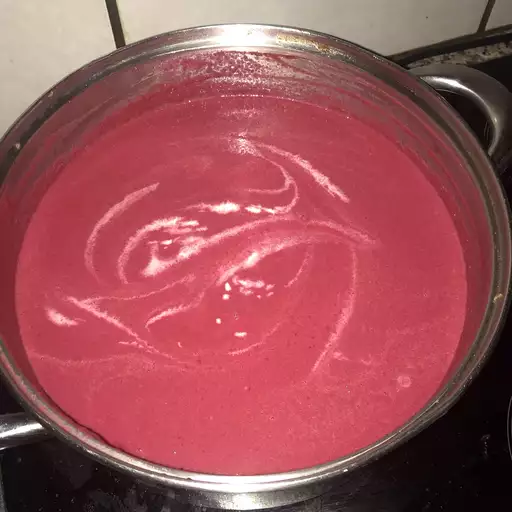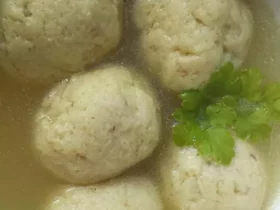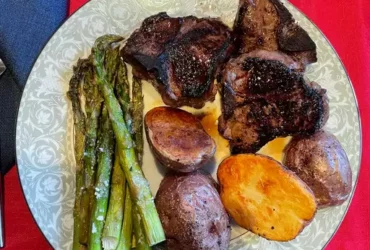Ingredients
Beetroot
- Beetroot, also known as beets or table beet, is a root vegetable that belongs to the Amaranthaceae family.
- It is an annual herbaceous plant with large, edible taproots that are typically round or oval in shape and range in color from deep red to gold or even white.
- The roots have a sweet and earthy flavor, which becomes more intense when cooked.
- Beetroot is rich in nutrients, including fiber, vitamins A and C, potassium, magnesium, and iron.
- It contains antioxidants called betalains that have anti-inflammatory properties and are believed to help protect against cancer, heart disease, and other chronic conditions.
- There are several varieties of beetroot, with the most common being Detroit Dark Red and Chioggia.
- Detroit Dark Red is a classic variety that produces deep red roots with a sweet, earthy flavor.
- Chioggia has white roots with pink or red veins and is known for its unique appearance as well as its sweet, slightly nutty flavor.
- The best beetroot for cooking is generally considered to be the Detroit Dark Red variety, as it holds its color and texture well when cooked.
- Beetroot can be used raw in salads or pickled, but it is most commonly roasted or boiled before use in recipes like soups, stews, and borscht.
- In terms of nutritional content, 100 grams of beetroot provides approximately 44 calories, 9 grams of sugar, 3 grams of fiber, and 1 gram of protein.
3 large beetroot
For this delicious Beet Soup recipe, you will need three large beetroot as a primary ingredient. Choose beets that are firm and have no signs of soft spots or bruises. This will ensure that they are fresh and of high quality.
The size of the beets is also important to consider. Large beets will yield more juice and flavor for your soup, making them an ideal choice for this recipe. You can select beets with a diameter of about 2-3 inches or slightly larger if available.
Before using the beets in the recipe, make sure to wash them thoroughly under running water to remove any dirt or debris. Pat the beets dry with a clean cloth or paper towel to remove excess moisture and prevent slipping during peeling and chopping.
When selecting the beets, also consider their color. While it may not affect the flavor, red beets will give your soup a more vibrant color compared to golden or yellow beets. However, you can use any variety of beetroot that is available to you and still achieve a delicious and flavorful soup.
In addition to choosing high-quality beets, consider storing them properly until you are ready to use them in the recipe. Place the beets in a plastic bag or wrap them tightly in aluminum foil and store them in the refrigerator at a temperature of 32°F (0°C) or below. This will help retain their freshness and texture.
Freshly picked, or choose a combination of red and gold for added depth
To craft a truly exceptional beet soup recipe, it’s essential to begin with an array of carefully selected ingredients that showcase the rich flavors and vibrant hues of beets.
Start by choosing either freshly picked or a combination of red and gold beets for added depth in language and color. Freshly picked beets will boast a more pronounced sweetness and earthy undertone, whereas a mix of red and gold beets will introduce an interesting dynamic of sweetness and bitterness.
You’ll need approximately four to five medium-sized beets, depending on their size, along with two tablespoons of olive oil for sautéing. Olive oil not only adds a subtle flavor but also helps bring out the natural sugars in the beets.
Next, finely chop one medium onion and two cloves of garlic, both of which will add layers of complexity to your soup. The sweetness of the onions will balance nicely with the earthy undertone of the garlic.
A handful of fresh parsley adds a bright, herbal note that will cut through the richness of the beets. You can use either curly or flat-leaf parsley for this purpose, although flat-leaf parsley offers a more intense flavor and aroma.
To add depth to your soup, you’ll want to include some aromatic spices like ground cumin, coriander, and paprika. These earthy spices will complement the sweetness of the beets beautifully.
A pinch of salt and pepper is essential for bringing out the flavors in your soup. You may also choose to add a few sprigs of fresh thyme or rosemary for added depth and aroma, although this is entirely optional.
For a creamy touch, you can add either heavy cream or coconut milk towards the end of cooking time. This will help balance out the earthy flavors and create a luscious, comforting soup.
In terms of liquid, you’ll need approximately four cups of chicken broth or vegetable broth, depending on your preference. You may also choose to use a combination of both for added depth.
Now that you have all your ingredients at hand, it’s time to begin cooking! The process will involve sautéing the onions and garlic in olive oil before adding the chopped beets and spices. From there, you’ll add your liquid ingredients and simmer the soup until the flavors have melded together beautifully.
Stock
A fundamental component of any soup, stock is the foundation upon which a rich and flavorful broth is built. In the case of beet soup, the stock plays a crucial role in bringing out the natural sweetness of beets and enhancing their earthy flavor.
Here are some common ingredients used to make stock for beet soup:
- Beef or Chicken Bones: These are the primary sources of collagen, gelatin, and other connective tissue that dissolve into the broth, adding depth and richness to the soup.
- Vegetables: Onions, carrots, celery, and garlic are commonly used in stock as they add a sweet and savory flavor profile to the broth. For beet soup, beets themselves can also be added to the stock for an intense beet flavor.
- Aromatics: Bay leaves, thyme, parsley, and peppercorns are often included in stock as they provide an aromatic and herbal quality to the broth that complements the natural flavors of the vegetables and beets.
In general, stocks can be made with a variety of ingredients depending on personal preference and the type of soup being prepared. Some common alternatives to beef or chicken bones include fish heads and shells, pork neck bones, and even mushroom stems.
4 cups of vegetable stock use storebought or homemade (Harvard School of Public Health recommends making your own)
The ingredients for a delicious and nutritious beet soup recipe are as follows:
Main Ingredients
- Beets: 3-4 medium-sized beets, peeled and diced (about 6 cups)
- Onion: 1 large onion, chopped (about 2 cups)
- Carrot: 2 medium-sized carrots, peeled and chopped (about 1 cup)
- Garlic: 3-4 cloves, minced (about 2 tablespoons)
Broth and Seasonings
- Vegetable Stock: 4 cups of vegetable stock, either store-bought or homemade (Harvard School of Public Health recommends making your own)
- Potassium Broth Powder (optional): 1 teaspoon (for added flavor and nutrition)
- Herbs and Spices: bay leaves, thyme, salt, and pepper (about 1 tablespoon of each)
Acidity and Sweetness
- Lemon Juice: 2 tablespoons (optional, for added brightness)
- Sweet Potato: 1 medium-sized sweet potato, peeled and diced (about 1 cup)
Remember to adjust the quantities according to your personal preferences and dietary needs.
Other Ingredients
- The main ingredients required for this classic Beet soup recipe are:
- 2 large beets (about 1 pound), peeled and chopped into small pieces
- 4 medium-sized potatoes, peeled and diced
- 1 large onion, finely chopped
- 3 cloves of garlic, minced
- 2 carrots, peeled and sliced
- 4 cups of vegetable broth
- 1 teaspoon of ground black pepper
- Salt to taste
The other ingredients that can be used to enhance the flavor and texture of this beet soup are:
- Freshly squeezed lemon juice (about 2 tablespoons)
- Sour cream or yogurt (optional)
- Chopped fresh dill or parsley for garnish (optional)
- Grated cheese (such as cheddar or feta) for added flavor
2 tablespoons olive oil
The first step in preparing Beet Soup is to gather the essential ingredients, including the primary component: beets. Olive oil, a crucial element for sautéing and adding flavor to the dish, is also required.
For this recipe, you will need 2 tablespoons of olive oil to heat up before adding other ingredients. The quality of the oil can significantly impact the overall taste and aroma of the soup. Choose a high-quality extra-virgin olive oil for the best results.
The use of olive oil serves multiple purposes in this recipe. Not only does it add a subtle yet distinct flavor to the beets, but it also helps to bring out their natural sweetness. As you heat up the oil, it will begin to soften and caramelize the edges of the sliced beets.
With the olive oil at the ready, move on to preparing the remaining ingredients, including onions, garlic, stock, and herbs. The combination of these elements will work together to create a rich and comforting Beet Soup that’s perfect for any occasion.
A key consideration when selecting your olive oil is its acidity level. For this recipe, you’ll want to use an extra-virgin oil with a mild acidity, as it will add a delicate flavor to the soup without overpowering the other ingredients.
As you continue cooking, keep in mind that the olive oil will be one of the primary components contributing to the overall flavor profile of your Beet Soup. Be sure to choose an oil that complements the earthy sweetness of the beets and enhances their natural goodness.
Salt and pepper, to taste
When it comes to enhancing the flavors of our Beet Soup recipe, two essential ingredients play a crucial role: salt and pepper, used to taste. These seasonings are fundamental in bringing out the natural sweetness and earthy undertones of beets.
Salt, also known as sodium chloride, is a mineral composed of sodium and chlorine atoms. It’s a vital component in our diet, essential for maintaining fluid balance and supporting various physiological functions. In cooking, salt serves multiple purposes: it enhances flavors, preserves food, and helps control bacterial growth.
There are several types of salt available in the market, each with distinct textures and flavor profiles. Some common varieties include sea salt, table salt, kosher salt, and Himalayan pink salt. Each type has its unique characteristics, such as coarser crystals, finer grains, or even a slightly sweet taste.
Pepper, on the other hand, is the dried fruit of the Piper nigrum plant. It’s primarily composed of capsaicin, which gives it a pungent flavor and aroma. There are several types of pepper, including black, white, green, and red peppers. Each type has its distinct color, texture, and flavor profile.
In the context of our Beet Soup recipe, salt and pepper are used to taste. This means that you can adjust the amount of seasoning according to your personal preference. Some people like a more subtle flavor, while others prefer a bolder taste.
When using salt and pepper, it’s essential to remember that a little goes a long way. Over-seasoning can quickly lead to an unbalanced flavor profile. Start with a small amount and gradually add more to taste.
In conclusion, salt and pepper are fundamental ingredients in our Beet Soup recipe. They enhance the flavors of beets and other ingredients, creating a delicious and savory dish. Remember to use these seasonings to taste and adjust the amount according to your personal preference.
Optional: sour cream or Greek yogurt for topping
When it comes to making beet soup, also known as borscht, the ingredients are a crucial part of bringing out the rich flavor and vibrant color of this Eastern European classic.
The main ingredient in beet soup is beets, which can be used fresh or pickled. Fresh beets are preferred for their sweet and earthy flavor, while pickled beets add a tangy and slightly sour taste to the soup.
Beets are typically peeled and diced before being sautéed in a mixture of butter or oil with onions, garlic, and sometimes carrots or celery. This mixture is often referred to as a mirepoix and provides a flavorful base for the soup.
Next, chicken or vegetable broth is added to the pot along with beef or pork bones (optional), which are simmered for at least an hour to extract their rich flavors and gelatinous goodness. The beets and vegetables continue to cook until tender, then the mixture is puréed in a blender or food processor.
Some recipes also include additional ingredients such as sauerkraut (for its tangy flavor), diced tomatoes, or chopped fresh herbs like parsley, dill, or chives. Sour cream or Greek yogurt can be used for topping, adding a creamy and cooling contrast to the warm and savory soup.
The finished beet soup is typically served chilled or at room temperature, garnished with additional fresh herbs and a dollop of sour cream or Greek yogurt if desired. This refreshing and flavorful soup makes an excellent addition to any meal, especially during the spring and summer months when beets are in season.
Cooking the Soup
Roasting the Beets
Cooking the Soup: This part involves heating up a large pot with some oil and sautéing the onions until they are translucent.
Next, add the minced garlic and cook for another minute or until fragrant.
After that, add in the diced beets along with the chicken or vegetable broth, salt, and pepper. Bring everything to a boil, then reduce heat and let it simmer for about 20-25 minutes, or until the beets are tender when pierced with a fork.
Roasting the Beets: While the soup is cooking, we can prepare the roasted beets that will add a rich flavor and vibrant color to our beet soup.
To do this:
- Preheat the oven to 425°F (220°C).
- Peel and chop the beets into wedges or small chunks.
- Place them in a baking dish, drizzle with olive oil, and sprinkle some salt and pepper on top.
- Toss the beets to coat evenly with oil and seasoning mixture.
- Roast the beets in the preheated oven for about 45-50 minutes, or until they are tender when pierced with a fork and slightly caramelized
Preheat oven to 425°F (220°C)
To cook the soup according to the beet soup recipe, begin by preheating your oven to a temperature of 425°F (220°C). This step is essential to roast the beets and carrots that will eventually make up the base of the soup.
While the oven is heating up, take a few moments to prepare the ingredients. You’ll need about three large beets and two medium-sized carrots, as well as a couple of tablespoons of olive oil for roasting.
Rinse the beets and carrots thoroughly under cold running water, then pat them dry with paper towels to remove any excess moisture. This step helps the vegetables roast more evenly in the oven.
Next, place the beets and carrots on a baking sheet lined with parchment paper, drizzle them with olive oil, and sprinkle with salt and pepper to taste.
Once the oven has reached 425°F (220°C), carefully slide the baking sheet into the oven and roast the vegetables for about 45 minutes to an hour, or until they’re tender and lightly caramelized. You can check on them periodically to make sure they’re not overcooking – you want them to still retain some of their natural sweetness.
While the beets and carrots are roasting in the oven, heat up a large pot on your stovetop over medium heat. You’ll use this pot later to puree the roasted vegetables into a smooth soup.
Once the beets and carrots have finished roasting, carefully remove them from the oven with oven mitts or tongs and set them aside to cool slightly. This is an important step, as you don’t want to burn yourself when handling the hot vegetables.
With the roasted vegetables cooled enough to handle safely, peel off the skins and transfer the flesh into a blender or food processor. You can also use an immersion blender right in the pot if that’s what you have on hand.
Add in any other ingredients you’d like to include in your soup – garlic, onions, chicken broth, cream – and blend until smooth and creamy. Taste and adjust seasoning as needed, then ladle the finished soup into bowls and serve immediately. Enjoy!
Wrap beetroot in foil and roast for 1 hour, or until tender when pierced with a fork
To cook the beetroot for the beet soup recipe, you will need to wrap it in foil and roast it in the oven. This step helps to bring out the natural sweetness and depth of flavor in the beets.
Here are the steps to follow:
- Preheat your oven to 400°F (200°C). This will ensure that the heat is evenly distributed and the beets cook consistently.
- Rinse the beetroot thoroughly under cold running water, removing any dirt or debris. Pat it dry with paper towels to remove excess moisture.
- Wrap each beetroot individually in a square piece of foil, making sure to cover them completely and seal the edges tightly. This will help trap the heat and steam inside the foil, cooking the beets evenly.
- Place the wrapped beetroot on a baking sheet lined with parchment paper, leaving some space between each one for even cooking.
- Roast the beetroot in the preheated oven for 1 hour, or until they are tender when pierced with a fork. You may need to check them after 45 minutes and rotate the baking sheet for more even cooking.
- Remove the beetroot from the oven and let it cool slightly. Once cooled enough to handle, peel the skin off the beets using a vegetable peeler or your hands (they will come off easily).
The roasted beetroot is now ready to use in the beet soup recipe. Simply chop or puree it as needed and proceed with the rest of the recipe.
Preparing the Stock
- To begin preparing the stock for your Beet Soup, it’s essential to start with high-quality ingredients.
- Select a mix of aromatic vegetables, such as onions, carrots, and celery, which will form the base of your stock.
- A large pot is necessary for this process, as you’ll need to accommodate all the vegetables and the liquid.
- Rinse the vegetables thoroughly under cold running water before chopping them into bite-sized pieces.
- For a basic beef-based stock, use about 2 pounds of boneless beef short ribs or oxtail per gallon of water. If using bones, make sure they are completely submerged in liquid during cooking.
- Add the chopped vegetables and beef to the pot, and fill it with cold water until all ingredients are covered.
- Bring the mixture to a boil over high heat, then reduce the temperature to maintain a gentle simmer.
- Average cooking time for a stock is 2-3 hours, though some recipes may recommend longer periods. Keep in mind that you can also make this stock ahead of time and store it in the fridge for up to 5 days or freeze it for several months.
Use storebought stock or follow your homemade recipe
- To cook the beet soup, start by peeling and chopping 2-3 large beets into small pieces.
- Next, sauté the chopped onion in a pot with some oil until it’s translucent, then add the chopped garlic and cook for another minute.
- Add the chopped beets to the pot and sauté them for about 5 minutes, or until they start to soften.
- Pour in 4 cups of store-bought beef stock or homemade stock made with beef bones, carrots, celery, and herbs like thyme and parsley.
- Bring the mixture to a boil, then reduce the heat to low and let it simmer for about 20-25 minutes, or until the beets are tender.
- Add some vegetable or chicken broth if needed to achieve the desired consistency.
- Season the soup with salt and black pepper to taste.
- Puree the soup using an immersion blender or a regular blender to get the desired consistency.
- Serve the beet soup hot, garnished with chopped fresh herbs like parsley or dill, and a dollop of sour cream if desired.
Finishing Touches
Puréeing the Soup
The final stage of preparing the Beet Soup involves adding the finishing touches and puréeing the soup to achieve a smooth, creamy texture.
Once you have removed the beets from the heat, let them cool slightly before pureeing them in batches using an immersion blender, stand blender, or regular electric blender.
If you prefer a more refined consistency, you can also use a fine-mesh strainer or food mill to strain out any remaining solids and achieve a silky, uniform texture.
When blending the soup, it’s essential to do so in batches, rather than pouring all of the soup into one blender at once. This will prevent overloading the blender and causing it to clog.
To enhance the flavor of your Beet Soup, you can also add a pinch of salt, some black pepper, or a drizzle of cream or sour cream to taste. Be cautious when adding these finishing touches, as they can quickly overpower the delicate sweetness of the beets.
Some people may prefer a slightly chunky texture in their Beet Soup, while others may want it completely smooth. Experiment with different blending techniques and add-ins to find your perfect balance between flavors and textures.
Peel roasted beets and transfer to a blender with stock and oil
The finishing touches are essential in bringing out the full flavor and color of this stunning Beet Soup recipe.
Now that you’ve roasted those beets to perfection, it’s time to peel them and transfer them to a blender with some key ingredients.
- Peel the roasted beets: Carefully remove the skin from the roasted beets, taking note of any tender spots that may remain. You can use a spoon or a paring knife to gently loosen and remove any stubborn bits.
- Transfer the peeled beets to a blender
Blend with stock and oil: Add the peeled beets to a blender along with some high-quality vegetable stock, which will add depth and richness to the soup. You can use homemade or store-bought stock, whichever you prefer.
- Add about 1/2 cup of oil:
- Neutral-tasting oil, such as grapeseed or canola, works best in this recipe to prevent any strong flavors from overpowering the beets.
This is where the magic happens! By blending the roasted beets with stock and oil, you’ll create a vibrant and flavorful soup that’s sure to delight your taste buds. Stay tuned for the next step in this recipe, where we’ll add some aromatics to take it to the next level.
Blend until smooth, adding more stock if needed for desired consistency
The final touches on a delicious beet soup recipe are just as important as the initial preparation and cooking process.
In order to achieve the perfect consistency, it’s essential to blend the ingredients until smooth. This can be done using an immersion blender or by transferring the soup to a blender in batches.
When blending the soup, start with short intervals and gradually increase the time as needed to prevent overheating or scorching of the soup.
The desired consistency may require additional stock, depending on how thick or thin you prefer your beet soup. To adjust the consistency, simply add more stock in small increments, blending well after each addition.
Some tips for achieving a smooth and creamy texture include:
- Using an immersion blender to avoid having to transfer the hot soup to a separate container
- Cooking the beets until they are tender, as this will help to break down their natural fibers and result in a smoother consistency
- Add a little bit of cream or coconut cream if you want a richer and more indulgent texture
- Not over-processing the soup, as this can cause it to become too thin and lose its flavor
The last step in finishing touches is to taste and adjust the seasoning as needed. Add salt, pepper, or other herbs and spices to enhance the flavor of your beet soup and make it your own.
Serving
The final touches to a dish, such as beet soup, involve not only presenting it visually appealingly but also considering how guests will interact with the meal during serving.
Carefully placing the bowls on a decorative tablecloth or placemat can elevate the dining experience and provide a warm ambiance for guests to gather around.
Placing garnishes such as fresh herbs, edible flowers, or thinly sliced beets on top of each bowl not only adds color but also fragrance, enticing guests to dig in. A dollop of sour cream, crème fraîche, or Greek yogurt adds a tangy contrast and cooling effect.
Serve the soup hot from a chafing dish or individual portions, allowing guests to serve themselves. This can be especially practical for large gatherings or buffets where options like this help maintain social distancing while still encouraging interaction.
Provide an array of accompaniments such as crusty bread, crackers, pickles, or chopped fresh herbs on the side, enabling diners to customize their experience based on personal preference. This adds a playful aspect and encourages guests to engage in conversations around the table.
An open bar with beverages like sparkling water, juices, wine, and beer can also complement the soup nicely. By offering various drink options, you cater to different tastes while allowing guests to indulge in socializing over refreshments.
Ladle into bowls, add a dollop of sour cream or Greek yogurt (optional)
The final stage of preparing this exquisite beet soup involves adding some finishing touches to elevate its flavor and texture. The last step before serving is to carefully ladle the hot soup into bowls.
This allows each bowl to retain a generous amount of the flavorful broth, making it easier to enjoy the combination of flavors in every spoonful. It’s essential not to overfill the bowls, as this might cause some guests to feel overwhelmed by the amount of liquid.
Now comes the optional but highly recommended part – adding a dollop of sour cream or Greek yogurt on top of each serving. This creamy element serves several purposes: it adds a rich texture contrast to the smooth soup, provides a subtle cooling sensation that complements the warm beet flavors, and helps balance out any lingering acidity from the beets.
The choice between using sour cream and Greek yogurt is primarily a matter of personal preference. Both options will yield excellent results, so don’t hesitate to experiment with either one (or both!) depending on your taste buds’ inclinations. If you decide to use both, simply add the dollop of Greek yogurt first, followed by a smaller amount of sour cream.
Before serving, make sure that each bowl is garnished with some fresh dill or chives, as these herbs not only add a pop of color but also infuse their distinctive flavors and aromas into every spoonful. This last touch will enhance the overall dining experience for your guests and leave them wanting more.
Finally, take this opportunity to share the story behind your beet soup with those gathered around the table – perhaps its origins in a family recipe or the inspiration that led you to experiment with such an intriguing combination of flavors. This adds an extra layer of meaning and warmth to the meal, transforming it into a memorable experience that extends beyond mere sustenance.
- Best Datanyze Alternatives for 2025 - April 24, 2025
- Best Hunter.io Alternatives for 2025 - April 22, 2025
- Best Lead411 Alternatives for 2025 - April 22, 2025













